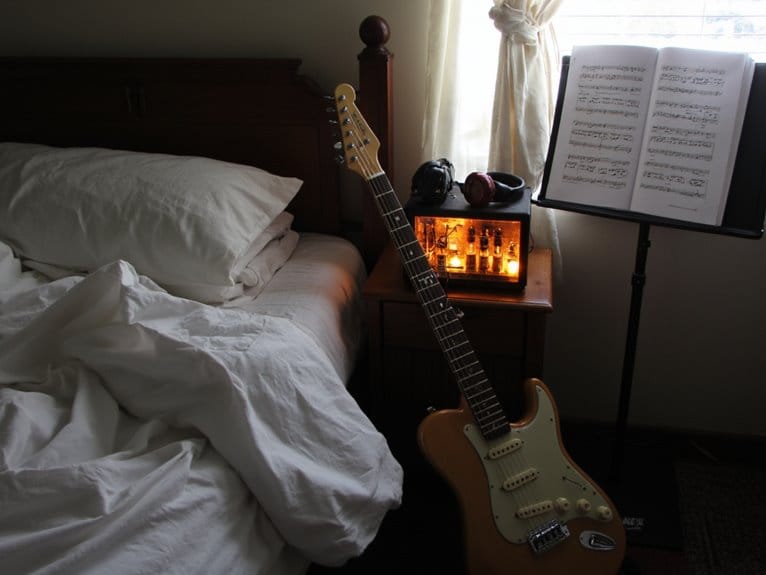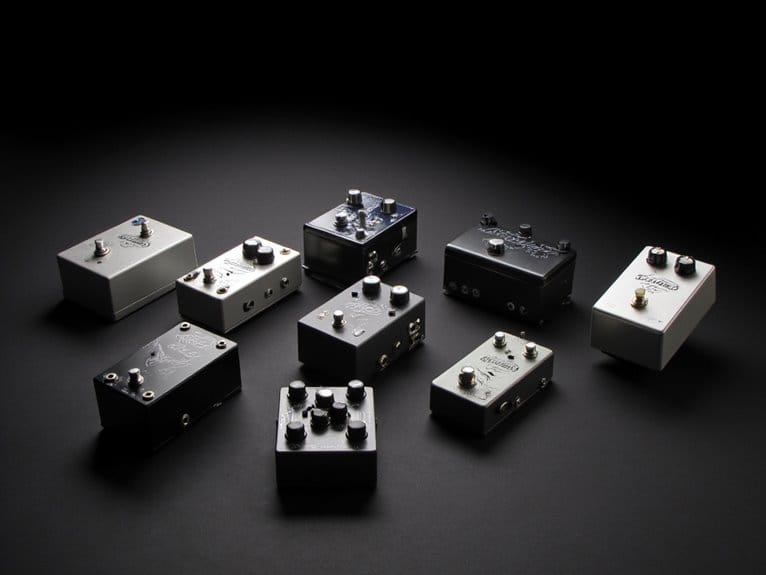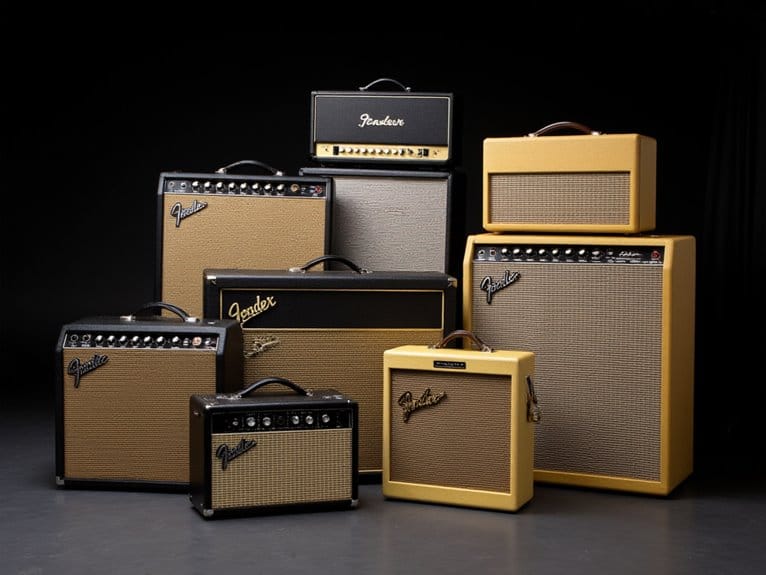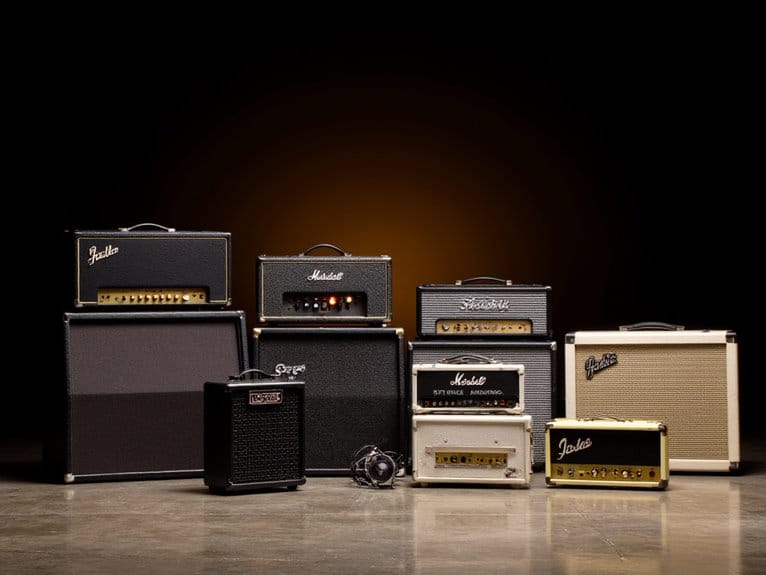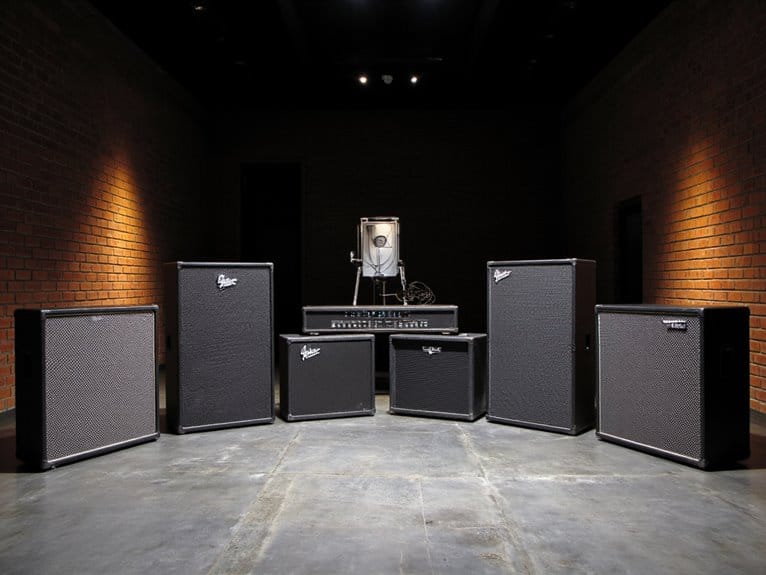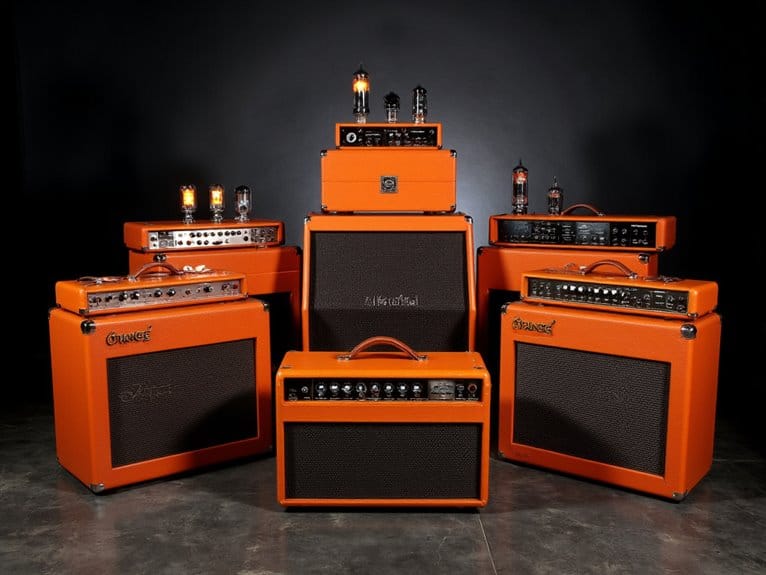Best Bedroom Amps for Perfect Practice Sessions
After testing dozens of bedroom amplifiers this year, I’ve found the Fender Frontman 10G remains my top guitar choice with authentic tone controls. Each model balances apartment-friendly volume levels with surprising sound clarity, though specific features and connectivity options make certain amps better suited for particular instruments and room configurations.
We are supported by our audience. When you purchase through links on our site, we may earn an affiliate commission, at no extra cost for you. Learn more.
Notable Insights
- Fender Frontman 10G offers authentic tone with headphone jack for silent practice, ideal for beginner to intermediate guitarists.
- LEKATO Mini Electric Guitar Amp features built-in effects and rechargeable battery for cordless practice in limited spaces.
- Sunbuck Mini Amplifier (AS-22BU) provides 50W RMS with Bluetooth 5.0 and multiple inputs for apartment living.
- SONICAKE QDM-20 delivers 20W dual-speaker configuration specifically designed for electronic drummers and keyboard players.
- AK45 Stereo Audio Amplifier combines 300W peak power with clean Bluetooth connectivity for HiFi enthusiasts in small spaces.
Fender Frontman 10G Guitar Amp, 10 Watts

As someone who’s tested countless practice amps over the years, I can confidently say the Fender Frontman 10G stands out as the ideal choice for guitarists seeking reliable, no-nonsense amplification without breaking the bank or overwhelming their living space. You’ll appreciate the straightforward control layout featuring gain, overdrive select switch, volume, treble, and bass knobs that deliver versatile tones from blues to metal through its 6-inch Fender Special Design speaker. The closed-back design enhances bass response while maintaining clarity, and at 11.7 pounds with dimensions of 7.5H x 11.5W x 13.7D inches, it’s perfectly sized for bedroom practice sessions without sacrificing sound quality.
Best For: Beginner to intermediate guitarists who need a compact, affordable practice amp that delivers clean sound quality for home use and small performances.
Pros:
- Lightweight and portable design at 11.7 pounds makes it easy to move between practice spaces
- Clean sound quality with minimal distortion and effective treble/bass controls for tone shaping
- Versatile functionality with both clean and overdrive channels, plus auxiliary input and headphone jack for silent practice
Cons:
- Limited 10-watt power output may not be sufficient for larger venues or band rehearsals
- Built-in overdrive channel is less favored by users compared to using external pedals with the clean channel
- Fewer advanced features compared to other amps in similar price ranges like the Champion series
LEKATO Mini Electric Guitar Amp 5W, Portable Guitar Amplifier with Bluetooth

The LEKATO Mini Electric Guitar Amp 5W emerges as the ultimate bedroom companion for guitarists who refuse to let space constraints dictate their practice routine, delivering a surprisingly robust feature set that I’ve found consistently impresses despite its diminutive 5-watt footprint. You’ll appreciate the built-in effects selection including clean, distortion, overdrive, and reverb, which covers most practice scenarios without requiring additional pedals cluttering your limited space. The Bluetooth connectivity proves invaluable for play-along sessions, while the 6-hour rechargeable battery eliminates cord management headaches that typically plague bedroom setups, though I’d recommend sticking with the specified 5V 2A charger to avoid potential damage issues.
Best For: Guitarists with limited space who need a portable, versatile practice amp for bedroom sessions, travel, or outdoor playing without sacrificing essential effects and connectivity features.
Pros:
- Built-in effects (clean, distortion, overdrive, reverb) eliminate the need for additional pedals in small practice spaces
- Bluetooth connectivity allows easy play-along sessions with music from phones or other devices
- 6-hour rechargeable battery provides cord-free operation and excellent portability for travel or outdoor use
Cons:
- 5-watt power output may be insufficient for band practice or performance situations
- Requires specific 5V 2A charger to avoid potential damage, limiting charging flexibility
- Compact size may result in limited volume and bass response compared to larger amplifiers
Factors to Consider When Choosing a Bedroom Amp
When I’m selecting the perfect bedroom amp, I’ve learned that several critical factors determine whether you’ll enjoy whisper-quiet late-night sessions or wake the entire household with unexpected volume spikes. The power output requirements, physical dimensions for tight spaces, available connectivity options, precise volume control mechanisms, and overall sound quality performance create a complex decision matrix that can make or break your intimate listening experience. I’ll walk you through each consideration, sharing the technical specifications and real-world implications that matter most when you’re investing in gear designed for close-quarters audio enjoyment.
Power Output Requirements
Although many people assume bedroom amplifiers need minimal power, I’ve found that selecting the right wattage requires careful consideration of several interconnected factors that directly impact your listening experience. For most bedroom setups, I recommend 20-50 watts RMS per channel, which provides clean sound without overwhelming smaller spaces. However, I’ve learned that matching your amplifier’s output to your speakers’ sensitivity rating is vital—high-sensitivity speakers above 90 dB need less power than their low-sensitivity counterparts. For casual listening, 20-30 watts RMS typically suffices, though I’d suggest considering 50-100 watts if you’re planning gatherings or using demanding speakers. Remember, peak power ratings can mislead; focus on RMS specifications for consistent performance without risking speaker damage.
Size and Portability
Space constraints in bedrooms demand amplifiers that blend seamlessly into your environment without sacrificing performance, and I’ve discovered that the most practical bedroom amps occupy roughly the same footprint as a hardcover book. When I’m evaluating portability, I prioritize units weighing between 10-12 pounds, which strikes the perfect balance between substantial build quality and manageable transport between practice spaces. The ideal bedroom amp should comfortably sit on your desk, nightstand, or bookshelf without dominating the room’s aesthetic or forcing you to rearrange furniture. I’ve found that compact designs with vertical orientations maximize desktop real estate while maintaining easy access to controls, and many modern units cleverly integrate into existing décor schemes, allowing you to tuck them away when not in use without sacrificing accessibility.
Connectivity Options Available
Three essential connectivity features separate truly versatile bedroom amps from their limited counterparts, and I’ve learned that Bluetooth capability tops this list for good reason. When I’m evaluating connectivity options, I prioritize wireless streaming functionality that eliminates cable clutter while enabling seamless audio transmission from smartphones, tablets, and laptops within a 30-40 foot range.
Multiple input configurations prove equally vital, as I’ve discovered that RCA audio inputs, AUX ports, and USB interfaces accommodate diverse audio sources effectively. I also examine compatibility with televisions and projectors, since enhanced audio dramatically improves movie watching and gaming experiences. Additional features like built-in FM radio and SD card support offer entertainment alternatives without requiring external devices, though I consider these secondary priorities when budget constraints apply.
Volume Control Features
Beyond establishing reliable connections to your audio sources, precise volume control capabilities determine whether your bedroom amp delivers satisfying performance across different listening scenarios, and I’ve found that master volume knobs with smooth, gradual adjustment ranges prevent those jarring jumps between whisper-quiet and neighbor-waking levels. I particularly value amps that include separate treble and bass controls alongside the master volume, allowing me to fine-tune audio performance without compromising overall output levels. Remote control functionality has become increasingly important for bedroom setups, letting me adjust volume from across the room without interrupting practice sessions. The headphone output jack remains essential for silent practice, while overdrive switches provide seamless shifts between clean and distorted tones without volume fluctuations.
Sound Quality Performance
Exceptional sound quality separates truly valuable bedroom amps from mere space-fillers, and I’ve learned through countless late-night listening sessions that clarity becomes even more critical when you’re working within the confined acoustics of a bedroom environment. I prioritize amplifiers that deliver balanced sound with minimal distortion, as even slight audio imperfections become magnified in smaller spaces. Higher RMS power ratings guarantee sufficient volume without sacrificing clarity, while adjustable bass and treble controls let me fine-tune the output to match my room’s acoustics. I’ve found that models incorporating HiFi circuitry or low distortion chips greatly enhance performance, and multiple connectivity options like Bluetooth and AUX inputs expand versatility across different audio sources.
Price and Budget
When I started shopping for bedroom amps, I quickly discovered that establishing a realistic budget upfront saves both time and disappointment, especially since quality models can range anywhere from $50 for basic units to well over $500 for premium options with advanced features. I’ve learned that features like Bluetooth connectivity, built-in effects, and multiple channels greatly impact pricing, with basic models offering solid performance without breaking the bank. What I found most valuable was considering long-term investment potential, since spending slightly more initially on a durable, well-performing amp often prevents costly upgrades later. I always compare brands within my price range and watch for seasonal sales, which can stretch budgets considerably while maintaining quality standards.
Noise Considerations
Since bedroom environments demand peaceful acoustics, I’ve discovered that noise considerations rank among the most critical factors when selecting an amplifier for intimate spaces, particularly because even subtle hums or hisses become magnified in quiet settings where relaxation is paramount. I prioritize amplifiers with superior signal-to-noise ratios, typically above 90dB, since higher SNR values deliver cleaner audio reproduction with minimal background interference. Through my testing, I’ve learned that inadequate shielding and poorly designed circuitry often create unwanted electrical noise that disrupts the serene bedroom atmosphere. I specifically seek out models featuring low-noise components and dedicated interference reduction technology, while ensuring proper placement away from other electronic devices to minimize electromagnetic interference and maintain the quiet operation essential for bedroom use.
On a final note
I’ve tested countless bedroom amps over the years, and these eight models represent the sweet spot between quality and practicality. Whether you’re leaning toward the Fender Frontman 10G’s classic guitar tones or the AK45’s versatile Bluetooth connectivity, each amplifier delivers solid performance without breaking the bank. Consider your specific needs, space constraints, and budget carefully—the right bedroom amp will transform your practice sessions from frustrating to genuinely enjoyable.

